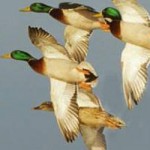Arkansas Waterfowl Report Shows Numbers Up During First Aerial Survey
LITTLE ROCK – Results from the season’s first aerial waterfowl survey show that Arkansas duck numbers are slightly higher than average for this time of year.
Arkansas Game and Fish Commission biologists conducted the November aerial waterfowl survey Nov. 18-20 in the Arkansas River Valley, Mississippi Alluvial Valley (Delta) and southwest Arkansas. Observers counted an estimated 938,546 ducks in the Delta, including 244,833 mallards). Biologists estimated a total of 22,627 ducks in the Arkansas River valley, including 7,038 mallards, and observed 19,145 ducks (4,455 mallards) in southwest Arkansas.
The Delta mallard population estimate (244,833) is slightly higher than the long-term average for mallards in November (225,000) but represents a roughly 50 percent drop from last year’s November mallard count. The total duck estimate is about 100,000 birds higher than the 2012 estimate as well as the long-term November average.
Analyses and biologist observations indicate a few higher-density locations among larger areas with few water and ducks.
About 50 percent of dabbling ducks were observed in agricultural fields. Some 25 percent were seen in agricultural reservoirs, not surprising given the dry conditions during this survey. Habitat use by mallards was similar, with about 20 percent of mallards observed in flooded rice fields and an additional 17 percent of mallard observations in moist-soil habitat.
Later crop harvests this year may provide a boost in the amount of food available to migrating and wintering waterfowl in Arkansas this time of year.
Cold weather arrived in The Natural State in a big way over the past week, and rainfall generally improved waterfowl habitat conditions across much of the state. But many popular public hunting areas such as White and Cache River national wildlife refuges and Bayou Meto Wildlife Management Area remain relatively dry.
Many parts of the state received beneficial rainfall late last week, putting water in agricultural fields and improving water levels in some bottomland areas, but more rain will be necessary to inundate areas to full pool.
The first segment of duck season ends Sunday. The second segment of the season runs Dec. 5-23, followed by the third and final segment Dec. 26-Jan. 26.
Courtesy Arkansas Game and Fish Commission












